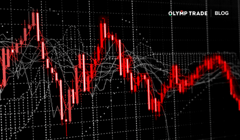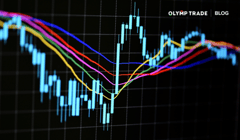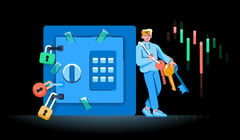
Traders need to be prepared for all kinds of market scenarios. These include the cases when the trends don’t adequately reflect the market sentiment. That’s when using contrarian trading strategies may be the best. This is Part 1 of the article, and it provides the fundamental approach to such strategies, which is most suitable for long-term trading. In Part 2, you will find the technical approach, and it is best used in short-term trading.
Contents:
- Trading with the Trend
- Trading Against the Trend
- Fundamental Factors to Understanding When the Crowd is Wrong
- Curious to Know the Technical Approach?
Interact with the dashed blue word and green spot on images to get additional details and explanations.
More details on the visuals will be here.
A term definition or explanation will be here.
Trading with the Trend
There are three types of trends in the market.
- When an instrument’s price goes up, that is a bullish trend or uptrend.
- When an instrument’s price goes down, that is a bearish trend or downtrend.
- When an instrument’s price moves within a certain price range, that is a flat trend.
The safest way to trade is to go with the trend. That is, to open trades in the general direction of the price movement. Essentially, it means following the market crowd.
With this approach, the probability of making a mistake and having losses is relatively low. However, such a strategy is not always the most profitable.
One of the reasons is that traders often join the observed trends too late. For example, they open traders in the trend’s direction when the trend has already started to fade or even change direction.
Another reason is that the crowd often makes mistakes in its Forex sentiment analysis. Practically speaking, that means that traders need to know when to leave the trend, let alone know the best time to join it.
As one famous market analyst wrote, “We must learn to betray the defeated in time and join the winners.”
Moving Averages, Donchian channel, Bollinger Bands, and Parabolic SAR are the most commonly used trend indicators with trend trading. They are good for identifying the current trend and finding entry points. However, they are not as useful in a flat market because the chance of making a mistake is much higher.
Trading Against the Trend
Contrarian trading strategies are another approach to trading. In a nutshell, it says that sometimes a trend may incorrectly reflect the market sentiment because the crowd is wrong in assessing it. Simply said, the trend may be false. Therefore, trades need to be opened against it.
In an uptrend, or bullish trend, the contrarian approach suggests opening a Down trade.
In a downtrend, or bearish trend, the contrarian approach suggests opening an Up trade.
A contrarian investor expects the market to reverse against the observed false trend, turning the trade he opened against it into a profitable one.
Contrarian trading brings higher risks because it can lead to higher losses.
At the same time, accepting these risks, traders expect higher profits.
Contrarian trading strategies are usually combined with fundamental analysis when used on large time frames and with technical indicators when used on small time frames.
Fundamental Factors to Understanding When the Crowd is Wrong
The fundamental analysis explained below is suitable for Forex traders on the Olymp Trade platform. Based on this Forex sentiment analysis, they can open long-term positions and hold them for several days or even a few weeks.
For those more interested in speculative trading and short-term trading against the trend, technical analysis is more suitable to find out when the crowd is wrong. Part 2 of this article is dedicated to that.
Psychology
Trading psychology is a key to understanding when the crowd is wrong. It requires traders to be able to answer meaningful questions about economic events.
For example, how does an economic bubble form, and what makes people aggressively buy assets? Let’s try to answer these questions using the case of the economic crisis of 2007-2008.
The Federal Reserve Chair, Alan Greenspan, kept the interest rate at low levels and followed a soft monetary policy for a long period. For most Americans, that meant more easily affordable housing, including those who wouldn’t be able to afford it at a higher key rate. That made the real estate market highly speculative. Houses were bought not to live in but to be sold on an expectation of a higher price later on. People were buying more houses, real estate prices were going up, and a bubble formed.
Later, the US key rate went up. People could no longer borrow as easily as when the rate was lower. As a result, the real estate market collapsed and triggered the biggest economic slump in American and world history. The bubble burst. That is how the US subprime mortgage crisis of 2007-2008 happened.
When the prices were peaking, most people in the market were focused on buying. Few thought that it all might soon stop, burst, and collapse. So, the crowd was wrong. Partly, it was misled by the media. Newspapers, television, and the Internet were mostly highlighting opportunities to make profits with the rising price of the real estate market. That was a false mainstream trend.
When everyone is convinced that a particular asset’s price will be going up or down for an extended period of time, it is often a mistake.
To help traders better understand which side the crowd is on, there are various indicators such as the Bullish Consensus and Forex sentiment analysis live. The Fear and Greed index indicator is specifically designed to assess the sentiment related to Bitcoin and other Altcoins.

The more extreme the indicator reading, the more the crowd is on the wrong side. In this case, you can try to open trades in the opposite direction.
Smart Money
Another element that helps assess whether the crowd is right or wrong is Smart Money.
If the crowd goes against Smart Money, it is most likely on the wrong side.
If you want to understand where Smart Money stands, check the weekly reports of the CFTC. Published every Friday, these reports shed light on the investment intentions of large institutional traders or commercial traders.
For example, the CFTC report published on March 15, 2022, showed that on the CME, there were many more buy or “long” positions than sell or “short” positions on GBP held by institutional investors.

A higher number of buy trades usually means that an asset is more likely to rise than fall. However, If the GBP price dropped at the time of such a report, that would mean that the crowd is wrong. In this scenario, opening trades against the crowd would seem a good opportunity.
Curious to Know the Technical Approach?
Go check Part 2 then. It will show how you can use contrarian trading strategies for short-term trading.
Trade NowRisk warning: The content of the article does not constitute investment advice and you are solely responsible for your trading activity and/or trading results.
Smart Money are the funds controlled by the market makers such as institutional investors, central banks, and other financial professionals.
The Commodity Futures Trading Commission is an independent US federal agency that regulates the derivatives markets including futures contracts, options, and swaps.
Chicago Mercantile Exchange, also known as the Chicago Merc, is a futures and options exchange.











